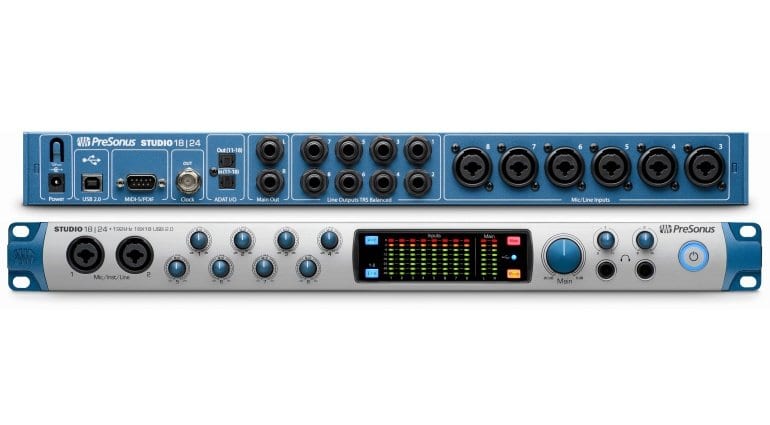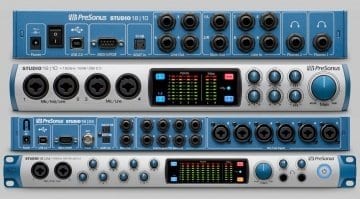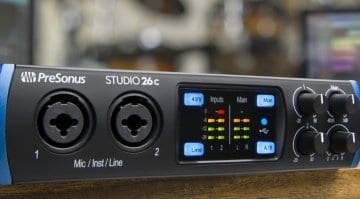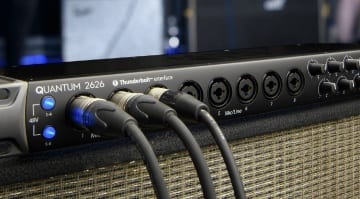NAMM 2018: PreSonus debuts Studio 1810 and 1824 rackmountable USB interfaces
PreSonus is back in the 19″ game, announcing a pair of new USB audio/MIDI interfaces in rack format – the Studio 1810 and Studio 1824. These are fairly interesting products, for they offer extensive connectivity at what could be considered budget prices. We’ll reflect on the commonalities between the two models before having a deeper look at each.
Both interfaces offer up to 24-bit, 192kHz resolution and integrate the latest PreSonus audio technology – namely XMAX Class A mic preamps, proprietary AD/DA conversion & clocking, and zero-latency monitoring with a dedicated DSP chip. Each ships with a comprehensive software package as well – a copy of PreSonus Studio One Artist, which is a full-fledged DAW with unlimited audio and MIDI tracks, virtual instruments, buses, and FX channels; the PreSonus UC Surface control software for PC & mobile devices, and the Studio Magic Plug-in Suite – a collection of seven plug-ins by renowned developers like SPL, Lexicon, Eventide, Brainworx, and Arturia.
PreSonus Studio 1810
Aimed at project studios, the 1810 can handle an overall 18 simultaneous inputs. The interface is equipped with 2 combo mic/instrument/line inputs, 2 combo mic/line inputs, 4 TRS line inputs, 8 ADAT optical channels (limited to 4 at 96 kHz), and stereo S/PDIF. Output-wise, there are 2 balanced main outputs with dedicated level control and mute, four balanced line outputs, stereo S/PDIF outputs, and 2 headphone outputs with A/B switching for selectable monitoring. All analog outputs are DC-coupled for sending control voltages.
PreSonus Studio 1824
Designed for larger studios, the Studio 1824 can handle a total of 18 inputs and 18 outputs. The interface is fitted with 2 mic/instrument/line inputs, 6 mic/line inputs, 8 channels of ADAT (limited to 4 at 96kHz), and stereo S/PDIF. Outputs include 8 balanced line outputs, a pair of main outputs with duplicate line outs, 8 ADAT channels (limited to 4 at 96kHz), stereo S/PDIF, and 2 headphone outputs. All line outputs are DC-coupled for sending control voltages. There’s also the presence of a BNC word clock output.
Price & availability
PreSonus will ship its new interfaces in the second quarter of 2018. Prices are 400 USD for the Studio 1810 and 500 USD for the Studio 1824.
Reflections
As is usual with PreSonus, the new Studio 1810 and 1824 interfaces disregard fancy features for a clean appearance and workhorse functionality, all at a competitive price. We remain fans of this strategy, exemplified by both PreSonus and direct competitor Focusrite, whose new Clarett USB interfaces are likely to play their part in many “which one to get” discussions. Truthfully, having to choose between either brand at the budget end of the market is a quality problem to have – one that’s mitigated by the opportunity to get a reasonably-sized home or project studio recording and connectivity hub for no more than 500 USD. What a wonderful time to be a recordist!
More Information
- PreSonus Studio 1824 Product Page
- PreSonus Studio 1810 Product Page
One response to “NAMM 2018: PreSonus debuts Studio 1810 and 1824 rackmountable USB interfaces”












The rear pictures does not match Presonus’s site…missing SPDIF and normal midi in/out jacks on their site